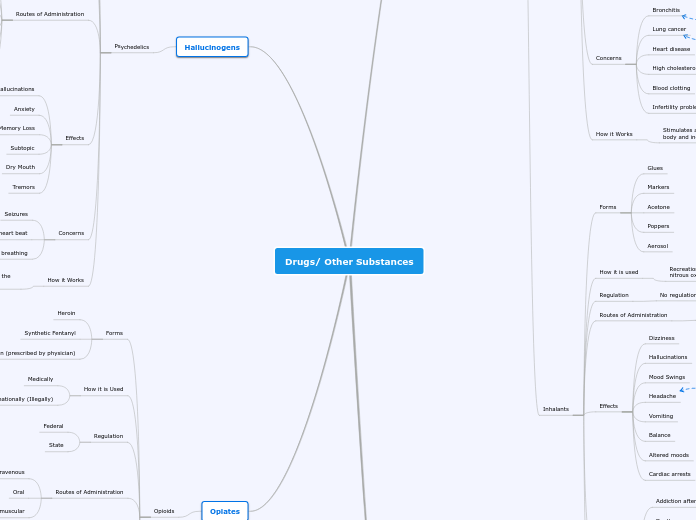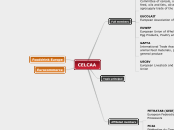Drugs/ Other Substances
Opiates
Opioids
Floods the brain with dopamine and blocks receptors to the brain, helping with reduction in pain.
Slow Heart Beat
Loss of consciousness
Very addictive
Constipation
Nausea
Drowsiness
State
Federal
Recreationally (Illegally)
Pain medication (prescribed by physician)
Oxycodone, morphine, hydrocodone... etc.
Synthetic Fentanyl
Heroin
Hallucinogens
Psychedelics
Stimulates the serotonin receptor 2A in the brain making the user feel an altered state of being.
Shallow breathing
Decreased heart beat
Seizures
Tremors
Memory Loss
Transdermal
Rectal
Intramuscular
Intravenous
Oral
Federal has it under a Schedule I drugs
Religously
Nightshade
Benadryl
Salvia
PCP
Stimulants
Hi
How
Methamphetamine
How it works
It increases the level of dopamine released in the brain. However, this excess dopamine is not stored or "recycled" for later. It creates an overstimulated brain that can only be replaced by a wave of unpleasant feelings which trigger the user to use again to feel good again.
Stroke
Paranoia
Effects sleeping patterns
Weight Loss
Dry mouth
Increased violence
Panic attacks
Increased perspiration
Hypothermia
Increased attention
Increased breathing
More energy
Injecting/dissolving
Snorting
Pill
Under Schedule II of the Controlled Substances Act
Recreationally
Medically
Subtopic
Speed
Glass/ Ice
Crystal Meth
Caffeine
The human body has receptors in the brain called adenosine, and caffeine helps to fool the adenosine receptors which usually bond with adenosine the brain makes. Caffiene helps block this bond from happening which prevents fatigue or exhuastion.
Effect bones
Fertility problems
Pregnancy issues
Decreased risk of oral cancer
Jitters
Rapid Heart Beat
Alertness
Drinking, chewing (gum), so orally
FDA requires labeling on any product that has caffeine in it.
Both Medical and Recreational
Soft Drinks
Pills
Tea
Coffee
Energy Drinks
Depressants
Inhalants
Depends on the inhalant, some have a similar effect on the brain as alcohol, others increase the size of blood vessels making your heart race.
Permanent brain damage
Muscle spasms
Hearing loss
Short term memory
Loss of concentration
Death
Addiction after long term use
Cardiac arrests
Altered moods
Balance
Vomiting
Headache
Mood Swings
Hallucinations
Dizziness
Inhalation
No regulation
How it is used
Recreationally mostly, however there is one medical use of nitrous oxide (laughing gas)
Aerosol
Poppers
Acetone
Markers
Glues
Tobacco
Stimulates adrenal glands which release epinephrine into the body and increases the level of dopamine.
Infertility problems
Blood clotting
High cholesterol
Heart disease
Lung cancer
Coughing
Dull smell and taste
Irritability
Anxiety
Mood stimulation
Poor vision
Increased heart rate
Topical, oral, inhalation, rectal, intranasal
The FDA has regulation on tobacco products under the Family Smoking Prevention and Tobacco Control Act. Must be at a certain age to purchase tobacco products, age varies state to state.
Recreationally, and if genetically modified by scientists medically for some autoimmune diseases
Etc.
Cigars
Gum
Patches
Pipe
Cigarettes
E-cigarettes
Chewing tobacco
Alcohol
It blocks receptors in the brain.
Dependence
Birth Defects
Heart damage
Liver damage/ cancer
Coordination
Fatigue
Blurry Vision
Slurred speech
Ingestion/ oral
Legal in all states in the US but must be over the age of 21
How its used
Recreational
All in liquid form, more other types exists
Whisky
Wine
Beer
Cannabis
How it Works
Increases the level of dopamine
Concerns
Bronchitis
Weakened Immune System
Increase risk of Lung Cancer
Effects
Increased appetite
Slow reaction time
Dry Mouth
Red Eyes
Increase or decrease anxiety levels
Increase your dopamine
Pain Relief
Routes of Administration
Edible
Goes into digestive track, then the blood stream, and then into the brain.
Smoking
Goes from lungs to blood stream and then into the brain
Regulation
Legal in 21 states for Medical use only age may differ state to state and depending on medical purpose
Legal in 12 states for both medical and recreational use over 21 years old
Illegal on Federal Level
How it is Used
Medical
Recreation
Forms
THC
CBD









